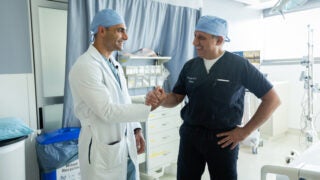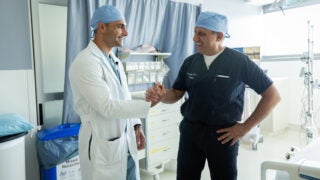Making private industries more diverse starts at USC
Experts discuss how bringing inclusivity and equity into the classroom could change industries for the better.
American newsrooms are overwhelmingly white. A 2018 Pew Research Center study found 77% of all newsroom employees identify as white and 61% as male.
But at the USC Annenberg School for Communication and Journalism, it’s a remarkably different story. More than 80% of graduate students and 55% of undergraduate students identify as non-white. When it comes to gender, the student body is more than 70% female, according to a recent diversity study.
“One of the unique things about the school is that the student body is more representative of the population than the professional industries they aspire to join,” said Gordon Stables, director of USC Annenberg’s journalism program.
That isn’t by accident. The school has prioritized recruiting diverse faculty members and students in recent years. It has also joined other USC schools in updating its curriculum with more diversity and inclusivity in mind. And because companies around the world view USC as a talent pool, these changes at the university have the potential to transform entire industries.
Some of the changes go beyond demographics.
USC’s focus on diversity, equity and inclusion could revolutionize work
In addition to training more diverse journalists, USC Annenberg is also rethinking established practices and the role of journalism in telling the stories of underserved communities.
“A classic bit of the journalistic canon was doing a ride-along with law enforcement,” Stables said. “The framing was about objectivity: If you are on the crime beat, you can learn by getting the perspective of law enforcement. There is no question that perspective is important, but if you begin with the framing that the only perspective is law enforcement, that is not a good thing.”
Professors also have students audit their source lists to ensure they speak with a variety of people and include diverse perspectives in their stories. And students at USC Annenberg now have space to write about people and issues that have historically gone unexamined. In 2016, students launched a Latino-focused news site called Dímelo. This summer, USC Annenberg launched a similar vertical focused on Black issues and communities.
Some of these changes are a response to input from students and alumni during the civil unrest of 2020.
“A lot of what we found is this notion of focusing on the value of careful truth-telling and being responsive to the community,” Stables said.
Our students will work in the world of today and tomorrow.
Anita Dashiell-Sparks
At the USC School of Dramatic Arts, Anita Dashiell-Sparks sees this as a “sea change” moment that could significantly transform society, from cultural institutions to industry.
“It is a necessity to foreground BIPOC and traditionally marginalized voices because this is what the 21st century demands in terms of artistry and industry,” she said, using shorthand for Black, Indigenous and people of color. “Our students will work in the world of today and tomorrow. As a leading school of dramatic arts and theater, the School of Dramatic Arts must examine, refine and update our best practices so that its faculty and students are best equipped to do work that is excellent, engaged and always relevant.”
The associate dean of equity, diversity and inclusion and co-head of undergraduate acting described how the school has given playwrights, artists, scholars and directors of color a more prominent place in the curriculum. School leaders have also reflected on how to train actors in the Me Too era by turning away from the traditional “studio system” in place since the 1950s. In this system, teachers often wield unquestionable authority over students, which sometimes leads to unequal and dangerous situations.
“It is a deep examination of how we do what we do, why has it been done that way and what can we do to adjust our practices to foster inclusivity and culturally responsive learning that is not built upon motivational tactics of fear and intimidation,” Dashiell-Sparks said.
USC schools of medicine and engineering also embrace new ideas
In medicine, USC leaders are embracing the opportunity to change a century of medical education that focused on two “sciences.” Health professionals historically learned about basic science, typically understood as lab research, and clinical science, or how to care for patients, said Ron Ben-Ari, associate dean of curriculum at the Keck School of Medicine of USC.
“For 100 years, we’ve talked about these two aspects of medical education. Now, over the past approximately five years, we have introduced health systems science as the third foundational medical science,” he said. “It’s the concept that we live in these systems of care and the systems themselves have multiple components like technology, safety, financing, access and all sorts of issues.”
That broader understanding of the landscape in which they will work allows medical students to become better advocates for their patients.
“So, for example, if you look at public health initiatives, the best thing you can do for homeless people’s health is give them a home,” Ben-Ari said. “Is housing now part of medicine, or is it something else? What about management of firearms or these things that have a huge impact on our health system but are not traditionally in the realm of what would be taught?
“At the Keck School of Medicine, we have introduced specific sections on residential segregation and structural racism and how those issues have impacted, and continue to impact, where people live and the likelihood that people of color or those who fall into a lower economic status are more likely to live in less healthy environments.”
You need to understand your patients in order to serve their health care needs.
Donna Elliott
This mindset also benefits doctors in tangible situations, said Donna Elliott, vice dean of medical education at the Keck School of Medicine.
“You need to understand your patients in order to serve their health care needs,” she said. “The classic example is you discharge a patient from the hospital, and you need to make sure they can get their medication. If you prescribe a medication that needs to be refrigerated, you need to make sure they have a refrigerator. When you give a person a follow-up appointment, you need to make sure they have transportation.”
At the medical school, the curriculum change also includes shifting from a traditional two-two model, in which a student’s time is divided into preclinical and clinical periods. The new model includes pre-clinical, clinical and post-clinical phases.
This subtle but significant shift will leave medical students better prepared for their post-graduation residency programs by ensuring they can prepare for the residency application process and the residency itself.
“The old model seemed a bit rushed because of the timing of applying for residencies,” Elliott said.
This change also allows students to devote time to an area of special emphasis like global health, health advocacy or community engagement. They can take a deep dive into a topic guided by faculty members who specialize in those areas. The post-clerkship phase includes time for research and specialty exploration, she added.
Diverse skill sets at USC aim to solve technical and societal problems
At the USC Viterbi School of Engineering, faculty members are similarly mindful of using engineering as a way to solve problems — both technical and societal. This involves finding new applications for technology while being aware of how they can benefit society.
Erik Johnson, the school’s vice dean for academic programs, described an example of this focus on artificial intelligence for social good from the dissertation of Fei Fang, the winner of USC Viterbi’s best dissertation award several years ago. Feng worked with researchers in USC’s Center for Artificial Intelligence in Society (CAIS), a joint effort of USC Viterbi and the USC Suzanne Dworak-Peck School of Social Work.
“Dr. Fang and colleagues worked with governmental and nongovernmental organizations to develop ways of using AI to catch poachers targeting endangered animals, particularly to protect tigers and elephants in Malaysia, building off earlier work that was tested in Uganda,” Johnson said. “Similar to policing in cities, there is a limited number of officers. So how do you make sure they are deployed in the areas that will best deter crime? If the wildlife law enforcement behavior is predictable, it is easy for the poachers to work around the authorities.
“CAIS researchers developed strategies for game wardens to change their patrolling patterns on a day-to-day basis. It wasn’t just random but based on where there were sightings and where the reports of possible poaching came from. Dr. Fang and colleagues were able to show significantly better coverage and deterrence.”
The engineering school is also expanding cross-disciplinary offerings because engineers work on problems that often need solutions from multiple fronts. Students learn how to work with other experts.
“Engineers can bring expertise and technological development and innovation but sometimes have less background in startup or development of workable business models,” Johnson said. “That’s where some folks from the USC Marshall School of Business, for example, who have both broader and deeper coursework in these complementary areas, can come in.”
In a recent set of courses, called “Innovation in Engineering and Design for Global Crises,” engineering students collaborate with others across campus to design, engineer and launch life-improving solutions during global crises, like the refugee crisis or the ongoing pandemic.
“Another example is a new joint graduate program in environmental data science,” Johnson said. “USC Viterbi is partnering with the USC Dornsife College of Letters, Arts and Sciences’ environmental studies program to look at how we can collect and process data to develop solutions to environmental problems.”
USC’s professors train to teach new, diverse curriculums
These broad curriculum changes can be challenging for instructors. In some cases, they need training or time and support to come up with new courses. That is easier said than done because they also typically learned from people who embraced a traditional perspective.
“The infusion of a more diverse and inclusive faculty is changing our perspectives,” said Esther Margulies, diversity and inclusion liaison at the USC School of Architecture. “They are leading the way to a more equitable and inclusive future.
“Many of us, especially the more senior faculty, were educated in U.S. or European institutions and were all taught that the highest levels of practice were generally white, male, European or European-educated architects. There were generally very few women and frequently no people of color.”
Margulies added that it is the faculty’s responsibility to expand teaching and research in equity and inclusion because it is essential to the success of professional and academic fields.
Because of this challenge, schools help their faculty members adapt by providing training sessions or developing guidebooks or resources regarding how to embed more diversity into their coursework. For example, instructors at the School of Dramatic Arts created a database of diverse resources to share with students.
“We have diverse playwrights, diverse authors and plays that foreground diverse identities at every single level,” Dashiell-Sparks said. “This is really something that makes my heart sing.”



